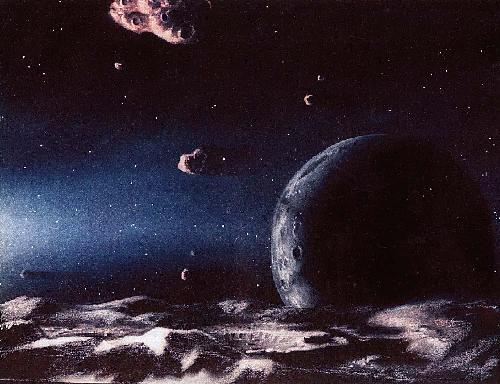Useful spectra have been difficult with even the Keck 10 meter telescope. Instead, we have obtained broadband colors of a number of KBOs and used these as a low resolution (but higher signal-to- noise ratio) substitute for spectra. Some results are plotted in the figure below. In addition, we have plotted the spectra of two Centaurs (objects in the vicinity of the gas giant planets that are thought to be recent escapees from the Kuiper Belt). The latter are marked "Pholus" and "Chiron" in the figure.
The figure shows that KBOs exhibit a wide range of optical colors, from nearly neutral (reflecting all wavelengths equally), to very red (red reflectance larger than blue reflectance). Furthermore, the range of colors (to be judged from the figure by the slopes of the spectra of each object) is about the same as that between the very red Centaur "Pholus" and the nearly neutral "Chiron". The wide spread of optical colors suggests considerable diversity in the materials present on the surfaces of KBOs and Centaurs.
How might this diversity arise? Prior to taking the measurements shown above, we expected that the surfaces of KBOs should all be dark and red, as a result of the prolonged and ubiquitous bombardment of these objects by cosmic rays. Laboratory experiments show that cosmic rays lead to the selective loss of hydrogen in surface materials, while promoting the formation of chemically complex polymers, many of which are dark and red because of their high carbon abundance. Carbonized, irradiated material is thought to be responsible for the blackened, refractory crusts observed on the nuclei of comets, for example.
We have two basic ideas about the origin of the color diversity. Firstly, it is possible that the KBOs possess intrinsically different compositions, and that the different colors are tracers of the compositional variation. Is this likely? In the main asteroid belt, asteroids indeed possess different compositions that seem to be related to their sites and temperatures of formation. The KBOs, as far as we know, all formed more or less where we now see them, in the space beyond Neptune. Their formation temperatures would all have been about 40 or 50 K, so it is hard to see how pronounced compositional differences might arise. But they might, and this is a possible interpretation of the data. Secondly, collisions in the Kuiper Belt might damage the cosmic-ray irradiated surface crusts on some object, revealing "fresh" material excavated from below. This process is seen on the Moon and other solid bodies, where recent impact craters have deposited sets of bright rays on the darker background material. We have simulated this "collisional resurfacing" process and find that color excursions of the observed magnitude might be sustained by collisions (within the very considerable uncertainties concerning the collision rates in the Kuiper Belt). The main condition is that the timescale for collisional resurfacing must be on the same order as the timescale for growth of the irradiation mantle.
Recently, R. Brown (U. Az) and colleagues reported a near infrared spectrum of the bright Kuiper Belt object 1993 SC. Although the spectrum they obtained is heavily smoothed, it appears to show absorption features that correspond approximately to features previously identified on Pluto. The similarity suggests a surface composition that is similar to that of Pluto, viz: frozen CO, CH4, and other ices mixed with dirt.
The existence of surface ices would imply recent emplacement, perhaps by slow outgassing (volcanism?) from the interior, or by collisional excavation of buried ices (see above). Alternatively, the absorptions might be due to complex organic materials in a cosmic-ray processed mantle.
See some recent spectral work on Kuiper Belt surfaces.

